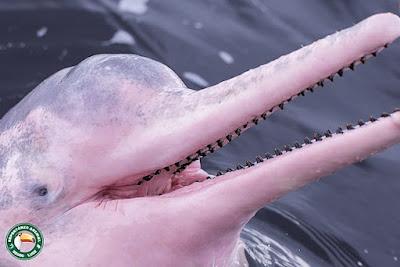The Amazon River Dolphin, scientifically known as Inia geoffrensis, is one of the most fascinating and enigmatic creatures inhabiting the vast waterways of the Amazon Basin. Also referred to as the Boto or pink river dolphin, this unique freshwater mammal captures the imagination of scientists, conservationists, and travelers alike with its mysterious beauty and remarkable adaptations.
Appearance and Habitat:
One of the most striking features of the Amazon River Dolphin is its unique pink hue, which intensifies with age. Though not all individuals display this distinct coloration - some are more greyish-blue - the pink tint is particularly notable in older dolphins and often deepens when they become excited or agitated.
In terms of size, Amazon River Dolphins can reach lengths of up to 8 feet and weigh as much as 185 kilograms, with males typically being larger than females. Their sleek bodies are well-adapted to life in the murky waters of the Amazon Basin, where they navigate through flooded forests, oxbow lakes, and extensive river systems.
Behavior and Social Structure:
Amazon River Dolphins are highly social animals, often found in groups known as pods. These pods typically consist of 2 to 10 individuals, although larger groups have been observed on occasion. Within these pods, individuals exhibit complex social behaviors, including cooperative hunting and communication through a series of clicks, whistles, and body movements.
Their playful nature is also evident as they engage in acrobatic displays, breaching the water's surface and performing spins and flips. Despite their sociable tendencies, Amazon River Dolphins are known to be elusive and shy around humans, making them challenging to study in their natural habitat.
Ecological Importance:
As apex predators, Amazon River Dolphins play a crucial role in maintaining the ecological balance of the Amazon Basin. Their diet primarily consists of various fish species, helping to regulate fish populations and control prey species' numbers. In turn, they themselves are preyed upon by larger predators such as caimans and jaguars, forming an integral part of the Amazon's intricate food web.
Furthermore, their movements and behaviors contribute to nutrient cycling within aquatic ecosystems, enhancing overall biodiversity and ecosystem health. By studying Amazon River Dolphins, scientists gain valuable insights into the Amazon's complex ecological dynamics and the interconnectedness of its inhabitants.
Despite their ecological significance, Amazon River Dolphins face numerous threats to their survival. Habitat loss and degradation due to deforestation, dam construction, and pollution pose significant risks to their populations. Increased boat traffic and accidental entanglement in fishing gear further exacerbate these challenges, leading to injuries and fatalities among dolphin populations.
Furthermore, Amazon River Dolphins are often hunted for their meat, oil, and traditional medicinal purposes, contributing to their declining numbers. Efforts to address these conservation challenges include the establishment of protected areas, community-based conservation initiatives, and research programs aimed at monitoring and understanding dolphin populations' status and behavior.
The Amazon River Dolphin stands as a symbol of the Amazon Basin's rich biodiversity and the need for concerted conservation efforts to safeguard its fragile ecosystems. As stewards of the planet, it is imperative that we work together to mitigate human-induced threats and preserve the habitats upon which these magnificent creatures depend.
By raising awareness, supporting conservation initiatives, and promoting sustainable practices, we can ensure that future generations continue to marvel at the beauty and wonder of the Amazon River Dolphin, a true jewel of the Amazon Basin.
Here are some interesting facts about the Amazon River Dolphin:
- Unique pink color: Amazon river dolphins, also known as botos, are famous for their distinctive pink color. While not all individuals display this coloration, it is especially prominent in older dolphins and can become intense when they become agitated or excited.
- Adaptations to murky waters: Their smooth bodies and long snouts are well adapted to life in the murky waters of the Amazon basin. Their long snouts help them navigate in flooded forests and locate prey in low visibility conditions.
- Freshwater habitat: Unlike marine dolphins, Amazon river dolphins are found exclusively in freshwater habitats, living primarily in the Amazon River and its tributaries, including oxbow lakes and flooded forests.
- Social animals: Amazon river dolphins are highly social animals, often found in groups called pods. These pods usually contain 2 to 10 individuals, although larger groups have also been observed.
- Communication and sonar: They communicate using a variety of clicks, whistles, and physical movements. These sounds are important for navigation, prey detection, and social interaction within their pod.
- Apex predator: As apex predators, Amazon river dolphins play an important role in regulating fish populations within the Amazon basin. Their diet mainly consists of various fish species, which helps to control prey populations and maintain ecological balance.
- Elusive Nature: Despite their social nature, Amazon river dolphins are often elusive and shy towards humans, making them challenging to study in their natural habitat.
- Conservation status: Amazon river dolphins face many threats to their survival, including habitat loss, pollution, accidental entanglement in fishing gear, and hunting for their meat and oil. As a result, they are classified as a vulnerable species by the International Union for Conservation of Nature (IUCN).
- Cultural significance: In Amazonian folklore, the boto is often depicted as a mystical creature capable of shapeshifting into human form. There are various legends and myths about these dolphins, with some indigenous cultures considering them sacred animals.
- Research and conservation efforts: Conservation efforts for Amazon river dolphins include the establishment of protected areas, community-based conservation initiatives, and research programs aimed at monitoring and understanding the status and behavior of dolphin populations.



Comments
Post a Comment